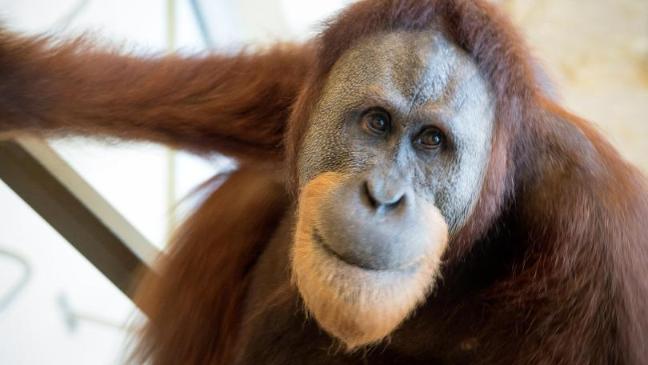By Nicholas St. Fuller, The New York Times, July 29, 2016
 |
| Rocky |
Orangutan hear, orangutan do.
Researchers at the Indianapolis Zoo observed an orangutan mimic the pitch and tone of human sounds, for the first time. The finding, which was published Wednesday, provides insight into the evolutionary origin of human speech, the team said.
“It really redefines for us what we know about the capabilities of orangutans,” said Rob Shumaker, director of the zoo and an author on the paper. “What we have to consider now is the possibility that the origins of spoken language are not exclusively human, and that they may have come from great apes.”
Rocky, an 11-year-old orangutan at the zoo, has a special ability. He can make sounds using his vocal folds, or voice box, that resemble the vowel “A,” and sound like “Ah.” The noises, or “wookies” as the researchers called them, are variations of the same vocalization.
Sometimes the great ape would say high-pitched “wookies” and sometimes he would say his “Ahs” in a lower pitch.
The researchers note that the sounds are specific to Rocky and ones that he used everyday. No other orangutan, captive or wild, made these noises. Rocky, who had never lived in the rain forest, apparently learned the skill during his time as an entertainment orangutan before coming to the zoo. He was at one point the most seen orangutan in movies and commercials, according to the zoo.
The researchers said that Rocky’s grunts show that great apes have the capacity to learn to control their muscles to deliberately alter their sounds in a “conversational” manner. The findings, which were published in the journal Scientific Reports, challenge the notion that orangutans — an endangered species that shares about 97 percent of it DNA with humans — make noises simply in response to something, sort of like how you might scream when you place your hand on a hot stove.
“Orangutans can clearly and carefully control their vocalizations, and they can do it in real-time interacting with another individual,” said Dr. Schumaker. “They can control the volume and the frequency and even the duration.”
To show the extent of Rocky’s vocal abilities, the researchers had Dr. Madeleine Hardus, an independent researcher who works with the zoo, hold a conversation with the orangutan entirely in “wookies.” She would say “Ah” at a certain tone and Rocky would mimic that sound for a treat.
“We presented him a random sequence of 500 either low or high ‘wookies’ produced by the human,” Adriano Lameira, a primatologist at Durham University in Britain, and lead author of the study said. The goal was to have Rocky repeat the sound in the same tone and frequency as the lady’s noise. They used 500 variants of “Ahs” to show that his responses were not random guesses.
The team recorded the tests and then used computer software to see how closely the frequency, pitch, tone and duration of Rocky’s “Ahs” matched Dr. Hardus’s “Ahs.”
“Every time she lowered her voice or raised her voice frequency, Rocky matched this up,” Dr. Lameira said. “And he nailed it. He was impressively good at it.”
To understand what Rocky did, imagine if you meowed at your cat and it was able to mimic you completely. You start out in a high-pitch voice and then your cat surprises you by responding with the same high-pitch call. And then when you drop into a Barry White voice, your cat responds with its own seductively deep meow to match.
Other scientists who have studied animal behavior and watched Rocky’s vocalizations were impressed.
“They say a picture is worth a thousand words — this video is worth the whole paper,” said Marc Bekoff, a behavioral ecologist and professor emeritus at the University of Colorado, Boulder, who was not involved in the study. “It was really clear how the orangutan was matching the vocalizations of the human.”
He added that the finding presents an important step forward in understanding the evolution of human vocal behavior.
“It provides an evolutionary explanation for what we take to be uniquely human behavior, and shows that we’re not that unique in this capacity.”
No comments:
Post a Comment